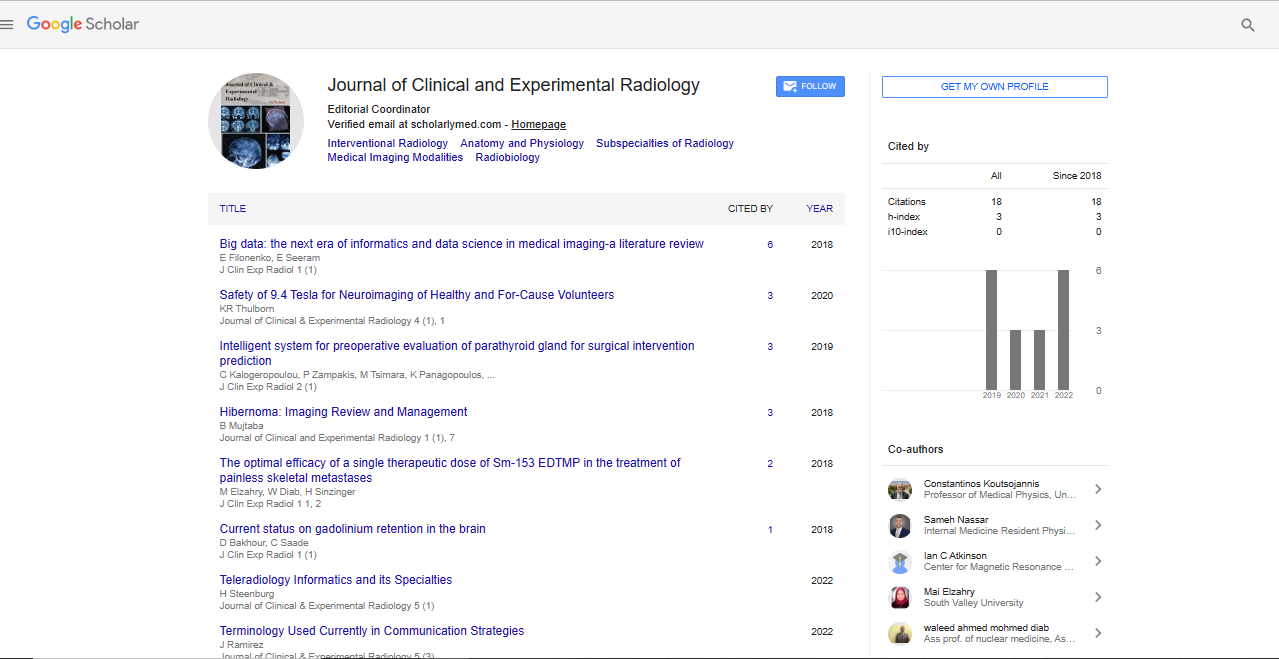Perspective, J Clin Exp Radiol Vol: 6 Issue: 2
Understanding the Biological Effects of Radioactive Materials
Dako Efren*
1Department of Radiology, University of Pennsylvania School of Medicine, Pennsylvania, USA
*Corresponding Author: Dako Efren,
Department of Radiology, University of
Pennsylvania School of Medicine, Pennsylvania, USA
E-mail: dako@efren.edu
Received date: 28 May, 2023, Manuscript No. JCER-23-106872
Editor assigned date: 31 May, 2023, Pre QC No. JCER-23-106872 (PQ);
Reviewed date: 14 June, 2023, QC No. JCER-23-106872
Revised date: 22 June, 2023, Manuscript No. JCER-23-106872 (R);
Published date: 28 June, 2023, DOI: 07.4172/jcer.1000139
Citation: Efren D (2023) Understanding the Biological Effects of Radioactive Materials. J Clin Exp Radiol 6:2.
Description
Radioactive materials are substances that emit radiation, which can have various biological effects on living organisms. The study of the biological effects of radioactive materials, known as radiobiology, plays a vital role in assessing the potential risks and developing safety guidelines for radiation exposure. This study provides an overview of the biological effects of radioactive materials, exploring the different types of radiation, their interactions with living systems, and the factors influencing the response to radiation.
Radioactive materials emit different types of radiation, including alpha particles, beta particles, gamma rays, and neutrons. Alpha particles consist of two protons and two neutrons and have a positive charge. Beta particles are high-energy electrons or positrons with a negative or positive charge, respectively. Gamma rays are electromagnetic waves with high energy and no charge, while neutrons are neutral particles. Each type of radiation interacts with living tissues in unique ways, leading to specific biological effects. When radiation interacts with living systems, it can cause various biological effects at the cellular and molecular levels. The primary mechanism of radiation damage is through the ionization of atoms and molecules within cells. Ionizing radiation has sufficient energy to remove electrons from atoms, leading to the formation of charged particles called ions. These ions can disrupt cellular structures, damage DNA, and interfere with essential cellular processes. Radiation-induced cellular effects depend on factors such as the type and energy of radiation, the dose received, and the sensitivity of the exposed cells.
At high doses, radiation can cause immediate cell death through damage to dire cellular components. However, at lower doses, radiation can induce sub lethal damage, leading to mutations, chromosomal aberrations, and altered cell function. These cellular effects can have long-term consequences, including an increased risk of cancer development. The biological effects of radiation extend beyond individual cells to tissues and organs. Different tissues and organs have varying levels of sensitivity to radiation. For example, rapidly dividing cells, such as those in the bone marrow and gastrointestinal tract, are highly susceptible to radiation damage. Radiation can cause acute effects, such as inflammation and tissue necrosis, as well as chronic effects, including fibrosis and impaired organ function. The severity and manifestation of these effects depend on the radiation dose and the specific tissue or organ involved.
One of the most significant long-term effects of radiation exposure is the increased risk of developing cancer. Ionizing radiation can damage DNA, leading to mutations that can initiate the development of cancerous cells. The risk of radiation-induced cancer depends on several factors, including the radiation dose, the age at exposure, and individual susceptibility. Different types of cancer, such as leukemia, thyroid cancer, and solid tumors, have varying latency periods and dose-response relationships to radiation exposure. Understanding the biological effects of radioactive materials is essential for developing radiation protection and safety guidelines. These guidelines aim to minimize radiation exposure and ensure the safety of individuals working with radioactive materials or in radiation-emitting environments. Effective radiation protection measures include shielding, time limitation, distance from the radiation source, and proper use of personal protective equipment. The implementation of safety protocols and adherence to regulatory standards are essential in preventing unnecessary radiation exposure and reducing the associated health risks.
The biological effects of radioactive materials encompass a wide range of cellular, tissue, and organ responses to radiation exposure. The understanding of these effects is vital for assessing radiation risks, developing safety guidelines, and protecting individuals from unnecessary radiation exposure. Ongoing research in radiobiology continues to enhance our knowledge of the biological effects of radiation, enabling more accurate risk assessment and improved radiation protection measures. By comprehending the biological effects of radioactive materials, we can strive to ensure the safe use of radiation and protect the health and well-being of individuals and the environment.
 Spanish
Spanish  Chinese
Chinese  Russian
Russian  German
German  French
French  Japanese
Japanese  Portuguese
Portuguese  Hindi
Hindi 